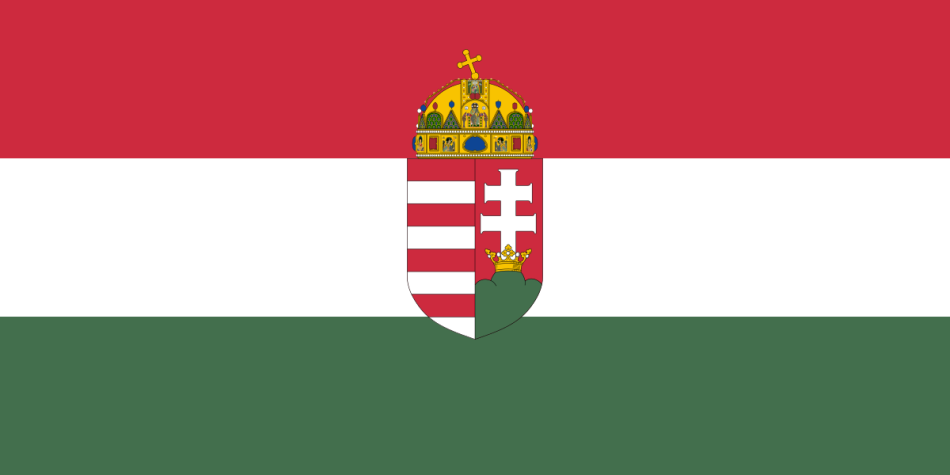Budapest, Hungary – National flags are an eloquent token of a country’s historical roots, cultural standing and political aspirations. They are, in other words, a concentrated version of a nation’s complex and changing identity.
This is why Kafkadesk has decided to explore the meaning of Central European flags and shed some light on the significance of symbols you might encounter on an everyday basis. On the agenda today: the Hungarian flag.
After covering Slovakia and the Czech Republic, the time has come to dig out the history of the Hungarian flag. Hungary’s national flag is made up of three horizontal stripes of red, white and green. It has known many changes and updates throughout history, but was officially adopted in the mid-20th century.
From Hungary’s medieval coat of arms…
The modern flag of Hungary finds its inspiration in the country’s Medieval coat of arms (see image below). On the left side, one can see the red and white Arpad stripes (tribute to the Arpad House, the ruling dynasty during more than two hundred years from the 9th century).
Similar stripes can be found on emblems of a number of cities located in modern-day Hungary, but also in Slovakia (Kosice, for instance). The four white stripes are said to symbolize the “four silver rivers” of the country (Danube, Tisza, Drava and Szava).
The right side features a double cross, placed atop three green hills – said to represent the Matra, Fatra and Tatra ranges of northern Hungary. It also shows the crown of Saint Stephen, considered by many the founding father of Hungary, with its unique bent cross on top. Other versions of the coat of arms, like the one displayed below, added angels on both sides of the shield.

Many scholars consider that the red symbolizes the blood spilt during battles, the green stands for the country’s mountains and fertile land, while the white is supposed to represent the country’s rivers. Others, however, claim that the flag’s colours are meant to highlight the strength (red), hope (green) and faithfulness or faith (white) of the Hungarian nation.
… to revolutionary designs
The modern-day design of Hungary’s flag is more directly linked to the revolutionary days of 1848. The horizontal tricolour is said to have been modeled on the French flag, and was meant as a tribute to the ideals of the French revolution.
The choice of the colours, on the other hand, was based on those included on the coat of arms. From 1848 to 1918, the Hungarian flag came in many different designs, alternating variants of the coat of arms always located in the centre.

Following the collapse of the Austro-Hungarian empire after World War I, the newly formed state of Hungary kept its tricolour flag. Once again, several variants were used from 1918 to 1949. The changes mainly pertained to the choice of the coat of arms’ size and version. You can see two examples below.


For the sake of accuracy, we should also add that the short-lived 1919 Hungarian Soviet Republic briefly changed the country’s flag, replacing it with a plain, red banner. The Slovak Soviet Republic had a similar flag at that time.

In 1949, communist authorities imposed a change in the Hungarian flag: despite keeping the three horizontal stripes, it replaced the country’s traditional coat of arms with a Soviet symbol located in the centre.

The Hungarian flag today
During the 1956 anti-Soviet uprising, Hungarian nationalists once again reinstated their own coat of arms, often by cutting out the Soviet emblem. Hungarian flags containing holes in the middle quickly became a powerful symbol of the country’s fight against oppression and struggle against communist rule.

Following the repression of the revolution, authorities removed, once more, Hungary’s coat of arms from the flag, but didn’t replace it with anything, simply leaving the three horizontal stripes.
It has been the official flag of Hungary every since: despite acknowledging the Medieval coat of arms as one of the state’s national symbols in 1990, following the collapse of the Soviet Union, Hungarian authorities chose not to incorporate it on the flag.


Great post 😁
It makes sense that the flag of the murderous regime of Bela Kun (1919) was all red, as it was a bloody, but thankfully, short lived regime.
Pingback: Where does the Slovak flag come from? – Kafkadesk
Pingback: Where does the Czech flag come from? – Kafkadesk
Pingback: Where does the Polish flag come from? – Kafkadesk
Good article, Hungary = ❤️
Valuable reading🇭🇺👏🏻❤️
Pingback: On this Day, in 1000: Stephen I was crowned as the first King of Hungary - Kafkadesk
Pingback: On this Day, in 1000: Stephen I was crowned as the first King of Hungary – Kafkadesk